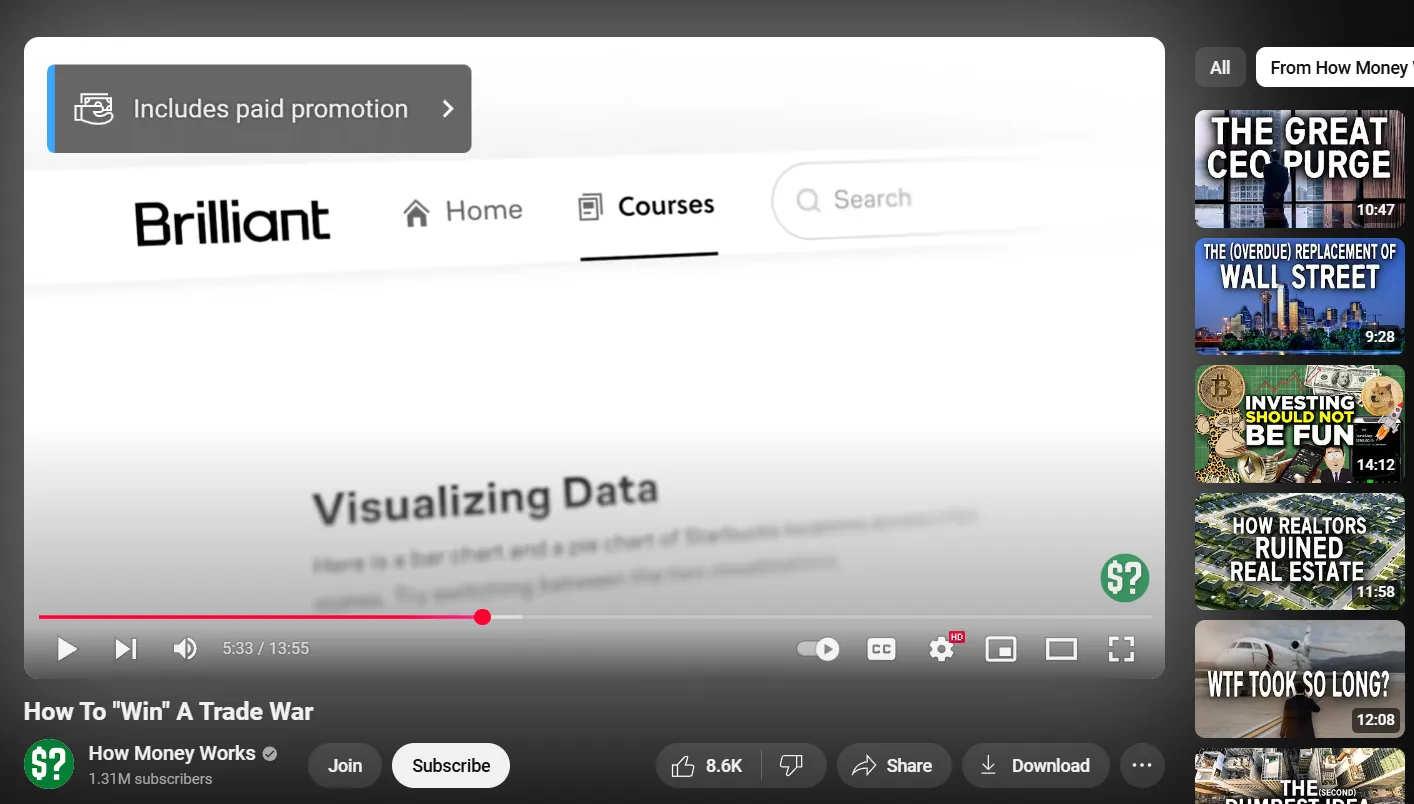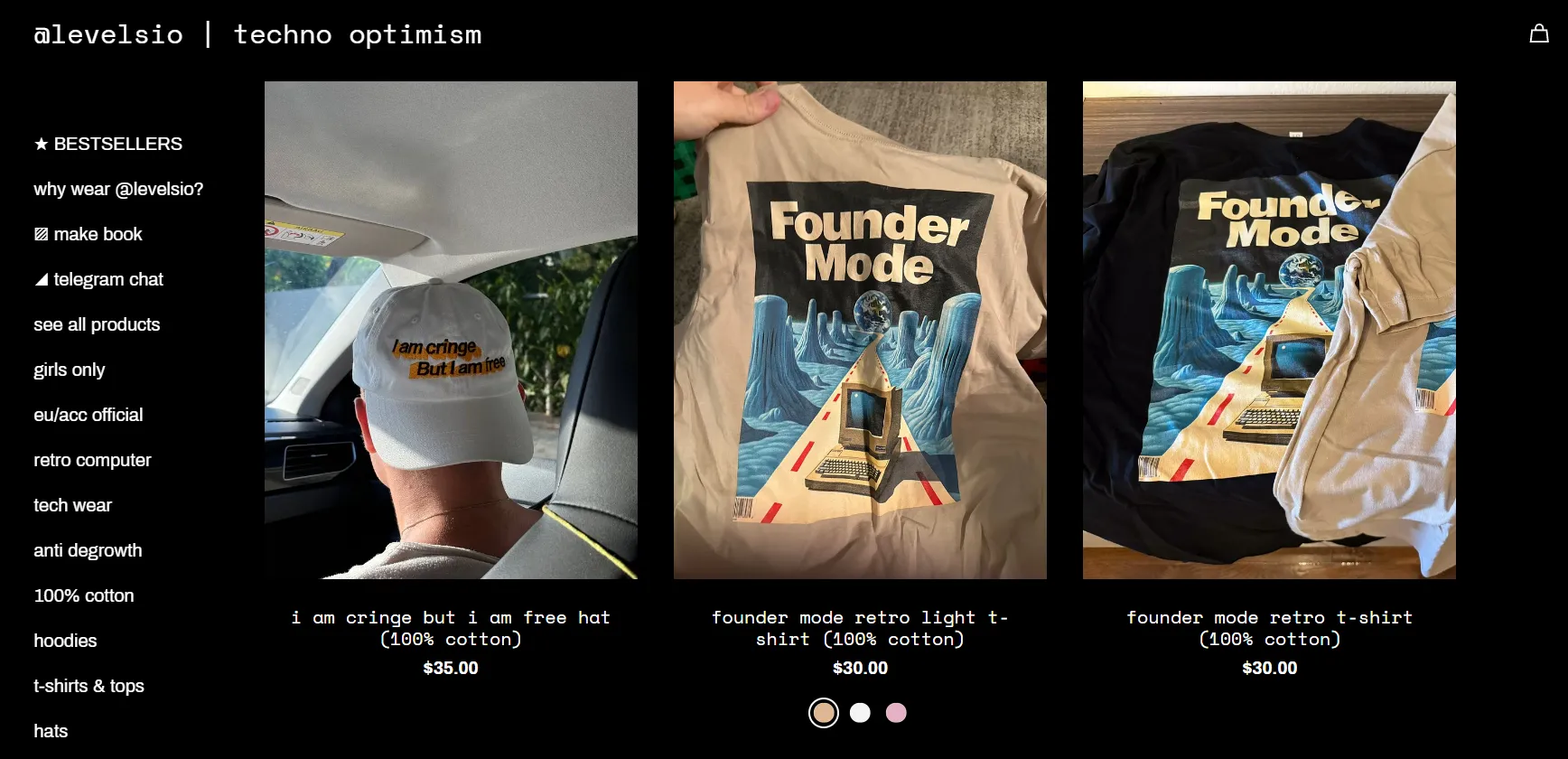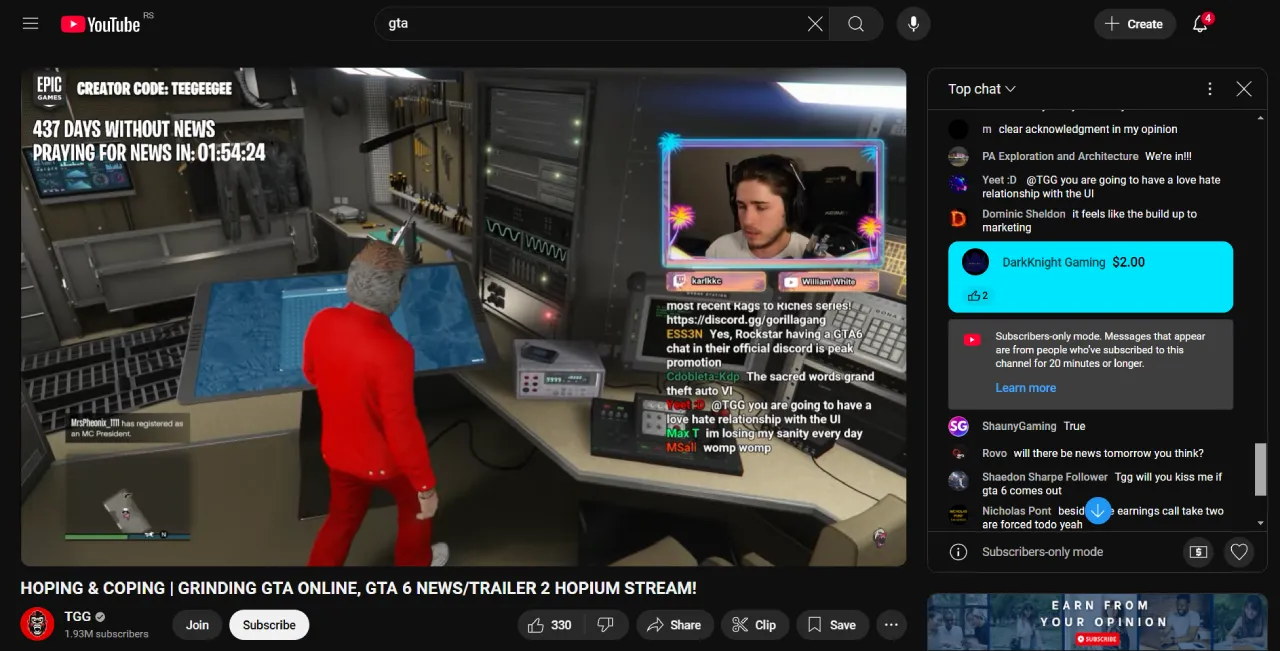YouTube is one of the best platforms for making money online, thanks to its unique combination of search-based and viral traffic.
As the second largest search engine in the world - right after Google - YouTube allows creators and businesses to reach a massive audience. What makes it even more powerful is its growing adoption on TV devices, transforming it into a primary entertainment source in millions of households.
Whether you’re an entertainer, educator, or business owner, YouTube offers endless opportunities. No matter your niche or target audience, you have the potential to grow and turn your channel into a valuable asset.
Video content isn’t just great for engagement; it also helps build a loyal, high-quality audience while giving you the perfect platform to sell products or launch a brand.
Many people think YouTube income is limited to the ads shown on their videos, but the truth is there are far more profitable ways to monetize your channel.
In this article, you’ll learn about 10 proven ways to make money on YouTube and explore example channels that successfully use each monetization method.
1. Ad Revenue
Ad revenue is one of the most popular ways to make money on YouTube, but it comes with its own set of requirements and considerations. To get started with ad monetization, you need to be part of the YouTube Partner Program (YPP), which allows you to earn money from ads displayed on your videos.

To qualify, your channel must meet certain criteria:
- You need at least 1,000 subscribers
- You must have 4,000 watch hours in the past 12 months
- Your account must be in good standing, with no community guidelines strikes
- You need to have an AdSense account linked to your YouTube channel
Once you meet these requirements, you can apply for monetization through the YouTube dashboard. YouTube will review your channel, and if everything checks out, you'll be approved to start earning ad revenue.
However, while ad revenue is a great way to make money, it's important to understand how factors like your audience's country and the niche you're in can impact your earnings. For instance, viewers from countries with higher ad spending, like the United States or Canada, tend to generate higher revenue per thousand views (CPM). On the other hand, audiences from countries with lower ad spending may result in lower CPM rates.
Your niche also plays a significant role. Channels that cover high-demand topics like finance, technology, and lifestyle tend to attract higher-paying ads compared to more niche or general content. For example, a video about investing or personal finance might have advertisers willing to pay more for placement, whereas a video about basic DIY crafts could have lower-paying ad opportunities.
One of the biggest risks with ad revenue is the potential for copyright strikes. This is particularly relevant for creators who use content that isn’t originally theirs, such as faceless videos that rely on clips from movies, TV shows, or other creators' material. If your videos are flagged for copyright violations, you risk losing access to monetization, or worse, having your channel suspended. Always ensure that your content is original, or that you have permission to use third-party material through licenses, fair use, or attribution.
Additionally, relying solely on ad revenue can be unpredictable. CPM rates fluctuate depending on market demand, seasonality, and changes in advertising trends. As a result, ad revenue can vary significantly month to month. It’s also important to note that YouTube takes a 45% cut of the ad revenue, so creators only receive 55% of what advertisers pay.
2. Affiliate Marketing
Affiliate marketing is a popular way to make money on YouTube by promoting third-party products or services and earning a commission for each sale made through your unique affiliate link.

Essentially, you recommend a product, and if viewers purchase it through your link, you get a percentage of the sale.
This method works well because it doesn’t require you to create your own products, and you can earn money by simply sharing useful items with your audience.
Affiliate marketing works in various niches, but it’s especially effective in areas like technology, beauty, fitness, finance, and lifestyle.
For example, tech YouTubers often promote gadgets, software, and courses, while beauty influencers can recommend makeup or skincare products. Fitness channels can promote workout equipment, supplements, or online fitness programs.
The potential earnings from affiliate marketing on YouTube can vary significantly. Successful affiliate marketers can earn hundreds to thousands of dollars a month, depending on the size of their audience, engagement levels, and the products they promote.
High-ticket items, such as electronics or software subscriptions, tend to offer higher commissions per sale, whereas lower-priced products may generate smaller commissions but can accumulate quickly with volume.
To place affiliate links in your video description, you need to verify your phone number with YouTube.
3. Community
Building a community on platforms like Skool, Circle, or Patreon is another excellent way to monetize your YouTube channel. By offering your audience exclusive content, digital products, weekly calls, webinars, and courses, you can create a steady stream of income through monthly subscriptions. These platforms allow you to charge a recurring fee for access to premium content and personalized experiences.

Many YouTubers are making tens of thousands - or even hundreds of thousands - of dollars by building tight-knit communities where people pay for access to valuable resources and ongoing interactions. However, it’s important to note that this strategy doesn’t work in every niche. To successfully convert your audience into paying members, you need to have a highly engaged and motivated audience that sees the value in your offering.
This model can be particularly effective for creators who produce entertaining content or long-form videos. Longer videos tend to attract quality audience ready to pay for more in-depth content, courses, or access to a community. If your audience is passionate about your content, they’ll be more likely to support your work on these platforms and invest in the exclusive offerings you provide.
4. Selling Digital Products
Selling digital products, such as courses or downloadable resources, is a highly profitable way to monetize your YouTube channel. Platforms like Teachable allow you to publish and sell online courses directly to your audience. You can teach anything from digital marketing to music production, coding, or fitness. Some creators have made millions by building and selling courses tailored to their niche.

By leveraging your YouTube channel, you can attract potential customers who are already familiar with your content. Once they trust you, they’re more likely to purchase your courses or downloadable products. This strategy allows you to generate income passively, as you create the product once and continue to sell it to new customers. With the right marketing and a loyal following, the potential for high earnings is limitless.
Digital products aren't just limited to courses; they can also include eBooks, worksheets, templates, printables, and other downloadable resources that add value to your audience’s life. With platforms like Teachable, you have full control over the pricing, content, and delivery, making it an excellent way to build a scalable business around your expertise.
5. Sponsored Content
In this monetization method, brands pay you to create content that promotes their products or services.
Unlike traditional ads, sponsored content typically involves integrating a brand’s message or product into your videos in a more organic and engaging way. This can include product reviews, unboxings, tutorials, or even dedicated videos highlighting a particular brand or service.

The key to success with sponsored content is having a strong, engaged audience that aligns with the brand's target demographic. Brands are more likely to partner with creators who have a loyal following and whose audience trusts their recommendations.
Many creators negotiate deals based on their views, subscriber count, and engagement metrics, but niche-specific channels with highly targeted audiences can get paid much more than regular CPMs.
Sponsorships can range from small businesses offering a few hundred dollars to large corporations willing to pay thousands for a video.
It’s important to disclose sponsored content to your audience in accordance with YouTube’s guidelines. Transparency builds trust, and viewers will appreciate your honesty about brand partnerships.
6. Merchandise Sales
Selling branded merchandise, such as t-shirts, hoodies, hats, or mugs, allows you to generate income while also strengthening your connection with your audience. Fans often love to support their favorite creators by purchasing items that reflect their unique style or personality.

Merchandise sales work particularly well in niches with passionate, engaged audiences, such as gaming, fashion, fitness, beauty, and music. This method works particularly well for younger audiences and highly targeted niche groups, who are more likely to purchase and wear branded apparel or accessories to express their support for a creator.
One of the best things about merchandise sales is that you don’t need to handle inventory or upfront costs. Print-on-demand services like Printful or Printify allow you to create and sell custom-designed merchandise without worrying about production, storage, or shipping.
These services handle everything from printing the designs to shipping the products directly to your customers when an order is placed. This means you can focus on designing the products and marketing them, while the print-on-demand service takes care of the logistics.
Print-on-demand is a low-risk way to sell merchandise without upfront investment. You only pay for the items that are sold.
7. Channel Memberships
This feature allows creators to offer exclusive content to the most loyal followers in exchange for a monthly subscription fee. Once you enable channel memberships, viewers can choose to become paying members of your channel, gaining access to special badges, emojis, exclusive videos, live streams, and other premium content.

To be eligible for channel memberships, you need to have at least 30,000 subscribers. You can set different membership levels with varying prices, each offering different content to cater to different types of viewers.
For example, a basic membership might offer custom emojis and access to members-only posts, while a higher-tier membership might include access to exclusive live streams or behind-the-scenes content.
Channel memberships work best when you have a highly engaged community that values your content and is willing to support you financially. It’s important to offer genuine value in the form of exclusive content or experiences that can’t be found elsewhere.
8. Super Chats
Super Chats are a feature available during live streams on YouTube, allowing viewers to pay money in exchange for their messages being highlighted in the chat. Viewers can choose to send Super Chats of varying amounts, which appear in different colors and stand out for a longer time, depending on how much is paid.

Super Chats are especially great for creators who do live Q&As, gaming streams, or shows. They make it easy for fans to get involved, support you directly, and have their messages stand out.
To be eligible for Super Chats and start earning from them, you must enroll in the YouTube Partner Program and your channel must have the ability to live stream.
People love to throw money at their favorite creators to get a little extra spotlight, and this feature gives them a chance to do just that.
MrBeast, one of the highest-earning YouTubers, has mentioned in the past that he makes tens of thousands of dollars from Super Chats during his live streams.
Keep in mind, YouTube takes a cut from this revenue (like with ad revenue), but it can still be a solid way to add another income stream, especially if you're consistently doing live content.
9. Selling Physical Products
While merchandising (like T-shirts) is a popular option, you can also branch out into other types of physical products, such as books, prints, accessories, or anything related to your niche.

For instance, a cooking channel might sell branded kitchen utensils, or an art channel might sell prints of their artwork. You can set up an online store (through platforms like Shopify or Etsy) and link it from your YouTube channel, funneling your audience to your store.
This can be a great way to get an initial boost in sales from an audience that already likes and trusts you. An initial boost is especially important if you're selling on marketplaces like Etsy or Amazon, as these platforms tend to promote popular products, particularly those who perform well during the launch phase.
10. Paid Reviews and Unboxings
Brands are always looking to get their products in front of potential buyers, and you get paid (or receive free stuff) for sharing your thoughts with your audience.
The key here is that you’re not just showcasing products, you’re helping your viewers decide whether they should buy them or not.

This works really well in a few different niches:
- Technology: Gadgets, smartphones, laptops, cameras, and tech accessories
- Beauty and Fashion: Makeup, skincare, clothing, and accessories
- Fitness: Workout gear, supplements, apparel
- Toys and Kids' Products: Family YouTubers reviewing toys, games, and educational items
- Home Goods and Kitchenware: Products like cooking gadgets, furniture, and home décor
- Gaming: New video game consoles, accessories, and games
A lot of creators make extra cash by joining affiliate programs like Amazon Associates, where they get a commission if people buy the product they reviewed through their link. Some even get paid just for leaving Amazon reviews (as long as they follow Amazon’s rules, of course).